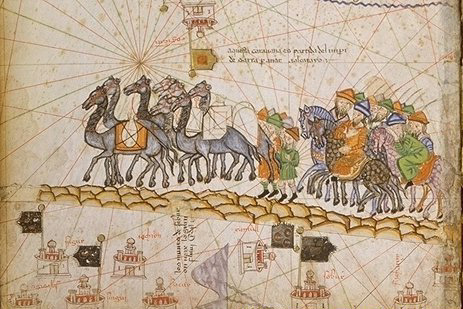The articles discusses the history of the Silk Road, the importance of silk, and the cultural and religious exchanges that occurred along its path.

History of Silk
Silk was a product discovered in China sometime around 2700 B.C. It is a textile woven from the protein fibers produced by silkworms in making their cocoons. Silk was a product initially reserved for the very wealthy and powerful people in China. Its process for production was a very carefully guarded secret for over 3,000 years; in fact, there were severe penalties, including death, for those that were found to reveal the secrets of silk to foreigners. Around the 1st or 2nd century, Silk first appeared in the Roman Empire, where it was considered an exotic luxury. Demand for silk remained extremely high throughout the duration of the reign of the Roman and Byzantine Empires, and thus, trading routes and networks between Asia and Europe via land and sea became established. These networks became known as the Silk Road, but at the time had no such name.
Along the Silk Road
Typically, Europeans acquired their silk through these networks, in turn, people in China acquired wool, silver, and gold this way. The route was a caravan path that wound some 4,000 miles from China, through the dusty mountains of Afghanistan, Persia, and the Arabian Peninsula, to the Mediterranean region of Europe. These caravans, typically led by horses or camels, would often stop at Caravanserais - primitive motels that allowed traders to rest, eat, gossip with other traders, and spend the night. These rest stops were often built within a day's journey of each other (about 25 miles) and were essential for traders on long journeys.
The Advancement of Society
Although silk was a primary product traded along the route, gunpowder, paper, metal work, precious gems and rocks, and even religious ideas, were exchanged between civilizations. The exchange of religious and cultural information between Europe, the Middle East, and Asia, is perhaps the most important aspect in considering the legacy of the Silk Road. Knowledge about science, technology, literature, art, and music, were also disseminated via the cultural interactions along the Silk Road. However, the exchanges that occurred were not all positive. The Silk Road is thought to be the manner in which the Black Death spread from Asia to Europe, killing between 30 and 60 percent of all Europeans in the 1300s. It was spread by fleas.Decline of the Silk Road
By the 15th century, the Silk Road was in decline, partly because of the Black Death, and partly because of the decline of the Mongol Empire, which led to widespread fighting and dangerous conditions along parts of the Silk Road. Furthermore, European explorers began searching for sea routes to Asia. Portugal's Vasco da Gama would become the first to travel by sea from Europe to India. Despite its decline, portions of the Silk Road remained in use until the 1800s!Related activities
Advertisement

